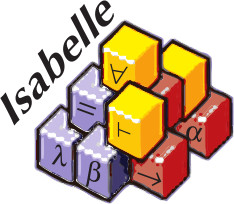
Common Pitfalls
-
Misleading variable naming in set comprehension
Problem: The expression
{(v, v). v ∈ {''a'', ''b''}}is actually interpreted as
{(va ∷ 'a, v ∷ char list). v ∈ {''a'', ''b''}}Fix: Write
{(v, v) | v. v ∈ {''a'', ''b''}} -
The simplifier does not apply my rule
Most commonly this is a typing problem. The rule you want to apply may require a more special (or just plain different) type from what you have in the current goal. Use
declare [[show_types, show_sorts]]to display types and sorts, and then check whether the types in your rule and your goal match up. -
What is the difference between the ⇒, ⟹ , and ⟶ arrows?
Isabelle uses the
⇒arrow for the function type (contrary to most functional languages which use->). Soa ⇒ bis the type of a function that takes an element of typeaas input and gives you an element of typebas output.The long arrows ⟶ and ⟹ are object and meta level implication, respectively. Roughly speaking, meta level implication should be used to separate the assumptions from the conclusion in statements. Whenever you need an implication inside a closed HOL formula, use ⟶.
-
Where do I have to put double quotes?
Isabelle distinguishes between inner and outer syntax. The outer syntax comes from the Isabelle framework, the inner syntax is the one in between quotation marks and comes from the object logic (in this case HOL). With time the distinction between the two becomes obvious, but in the beginning the following rules of thumb may work:
Types should be inside quotation marks, formulas and lemmas should be inside quotation marks, rules and equations (e.g. for definitions) should be inside quotation marks, commands like
lemma,definition,primrec,inductive,apply,fun,doneare without quotation marks, as are the names of constants in constant definitions (consts)